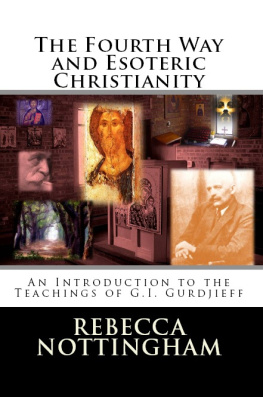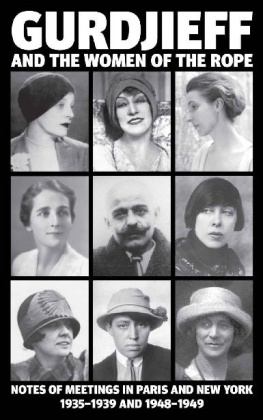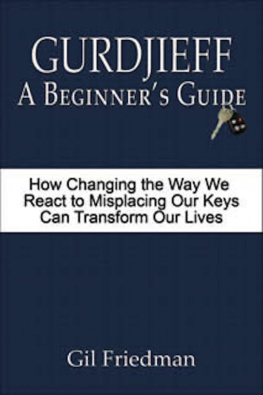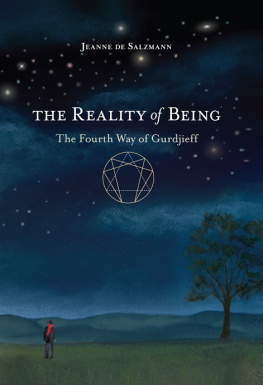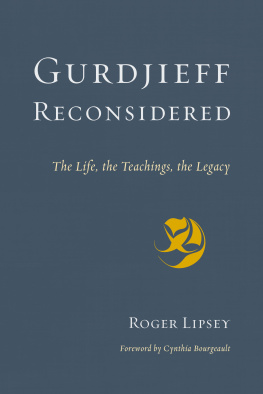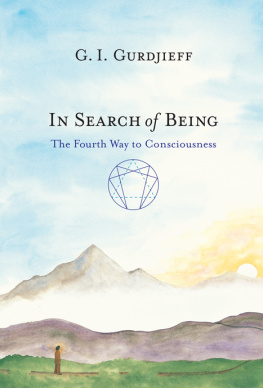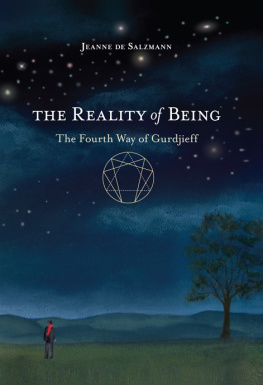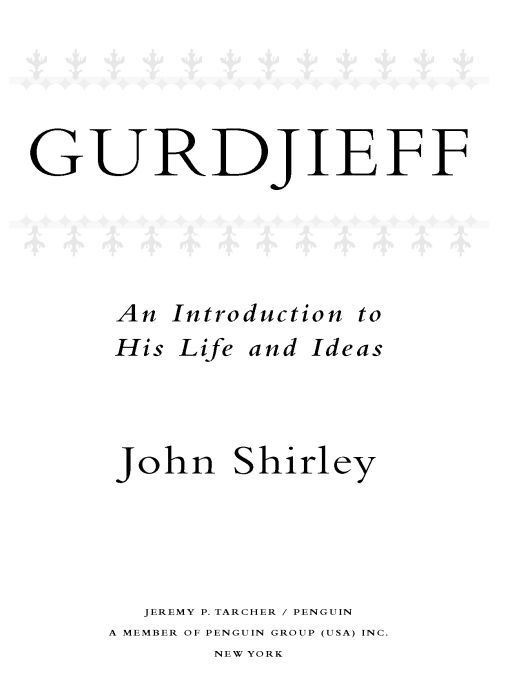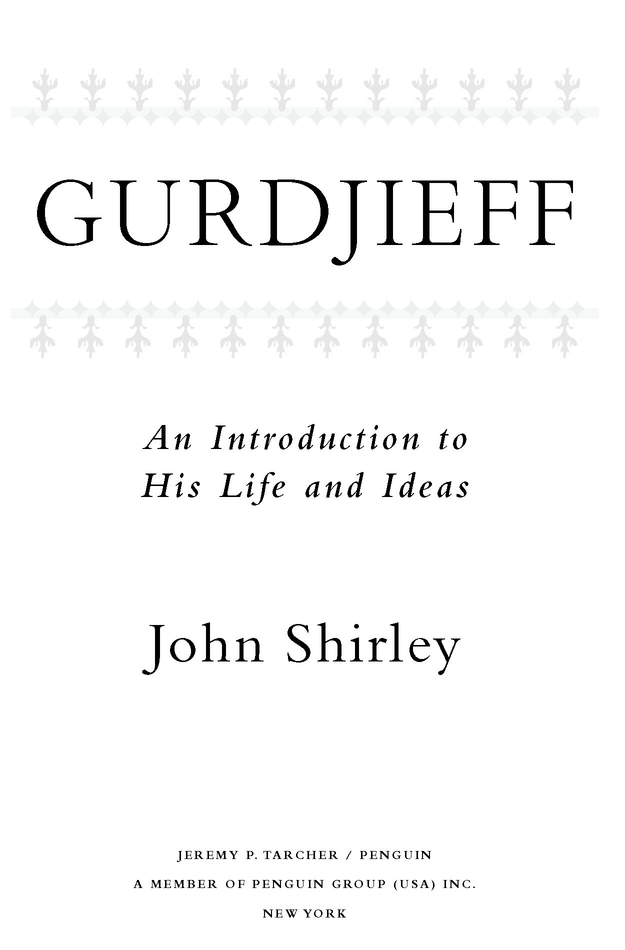Table of Contents
Very special thanks to Jacob Needleman
Very distinctive thanks to Mitch Horowitz
Lots of large thanks to Daniel Duncan
Unique thanks to Richard Smoley
Very particular gratitude to Chuck St. John
for help on several levels
Vast gratitude also to Walter Driscoll, Micky Shirley,
Richard Sandor, and Mitch Ryan
Thanks to Barry Schoor
AND
Special thanks and credit to Paula Guran for
digital rendering of diagrams
There is a thousand times more value even
in polishing the floor as it should be done
than in writing twenty books.
G . I . GURDJIEFF
This book is dedicated to the memory of those who have now passed on, who inspired this book either directly or through their pupils. I met only a few of them, and only briefly, but somehow I feel all these people were part of the current of inspiration that energized this book.
Jeanne de Salzmann
John Pentland
William Segal
Michel de Salzmann
A. L. Staveley
David Langmuir
FOREWORD
WHY THIS BOOK, PARTICULARLY,EH?
First, why this book at all? Besides the usual scruffy personal reasons an author writes a book, why write an introductory volume on G. I. Gurdjieff now?
There is, it seems to me, a certain urgency, at least a need, for an updated, compact, straightforward book on Gurdjieff for the general public. The terror of the situation, in Gurdjieff s phrase, is with us intensely in the twenty-first century. We feel real fear when we contemplate humanitys unconsciousness of its own violence, the brutality it enacts while sleepwalking. This has always been with us, of courseevery generation has its own crises but some feel were reaching a kind of social critical mass. It may indeed be only the latest of many social flashpoints; but its not impossible that the fatal chain reaction has already begun. The human world always has been in danger; it might be in greater danger now than ever before, due to the various risks accompanying globalization, and the ever-increasing technology of war. If the danger is greater now, then the need for people to understand themselves is greater, tooon every level.
The lifestyle of the twenty-first century is like a powerful giant who wont be denied: the laser-sharp efficiency of the entertainment media and modern demands on our time make it harder than ever to find the real meaning at the core of life. As Professor Jacob Needleman has it, in his book Time and the Soul:
In fact, everything we call progress is actually measured by the degree to which it enables us to conduct ourselves without the need to bring thought into conscious relationship with movement or feeling. We measure progress by the automaticity by which we are enabled to conduct our lives. Even thinking, or what is called thinking, is being performed more and more by machines. These machines are supposed to liberate usbut for what?
Are machines liberating us only so we can retreat into the lethargy of digital entertainment, within a technological womb?
It doesnt matter when youre reading this, since the terror of the situation is perennial. Gurdjieff s teaching, showing humanity how it is asleeptrapped in interlocking patterns of individual neurosis and collective psychosisis always a teaching urgently needed.
G. I. Gurdjieff s intention, after all, was to begin something truly new (at least, new to modern man), to ring a bell whose tolling would wake others. Such people would then take up the same reverberation, conduct the same current, eventually waking up enough people to change the course of history. But the process comes about through individuals, and most people are struggling to awaken for their own sakes first. They struggle to awaken for the benefit of their souls. The need to waken, the serious hunger to waken, is vital.
Certainly there exist more substantive, knowledgeable books on Gurdjieffs ideas than this could ever be: apart from Gurdjieffs own works, there is, for example, In Search of the Miraculous: Fragments of an Unknown Teaching by P. D. Ouspensky. But it seems to me that in this harried, media-saturated age, an introductory book is called for, a straightforward book that speaks with at least a respectable accuracy on the subject; a book that might open a door, for some readers, to a deeper study, and even real hope.
AND WHAT OF MR. GURDJIEFF HIMSELF...?
Born in Russian Armenia, probably in 1866 (conflicting dates have been offered), his father Greek, his mother Armenian, the young man later known as George Ivanovich Gurdjieff set out to bring to light the secrets of life and death.
Some say he succeeded, by the time of his death in Paris in 1949. Certainly he searched for decades through the most resistant topography of the Middle East and Asia; from Afghanistan to Tibet and India; from Turkey to Africa. He found his way to remote monasteries others had written off as mere legend; to secretive spiritual masters and to the mastery of spiritual secrets.
To pay for his quest he found it necessary to be variously an impromptu entrepreneur, a professional hypnotist, an importer of exotic rugs, even, at least once, a performing fakir; he endured a host of exotic diseases, returning home to recover from illnesses that felled many another man and discouraged even more. Yet his will to find out the truth, his wish, carried him through these rigors, past power-possessing men bristling with weapons, through civil wars, and eventually through the chaos of the Russian Revolution. He was shot, he tells us, three timesand saw significance in the fact that all were stray bullets.
Many of the details of his early history and his quest are difficult to document, and thus arguable. What is certain is that Gurdjieff and his philosophy hit the inquirer like an unexpected icy shower, at the very least leaving an unforgettable impression: a welcome shock of wakefulness.
When Gurdjieff set out to teach what he had learned, he laid out a system that reinterpreted mans most fundamental dilemmas. He stunned the mathematician and metaphysical philosopher P. D. Ouspensky, among others, with a host of revelations, including: a detailed cosmology; a depth psychology; a new understanding of the nature of consciousness; a historical revisionism that includes a radical and unprecedented approach to understanding human history and the annals of metaphysics; a specialized music integrated with a theory of the relationship of octaves to man and the cosmos; an intricate choreography of spiritually instructive dance; specific methodologies for increasing consciousness and harmonizing inner disunity; and a breathlessly timely fusion of Western scientific method with the wisdom of the East. Here is Ouspenskys In Search of the Miraculous: I was most of all interested in the connectedness of everything he said. I already felt that his ideas were not detached from one another, as all philosophical and scientific ideas are, but made one whole, of which, as yet, I saw only some of the pieces.
Gurdjieff said that there were basically three Ways for the growth and maintenance of a soul: the way of the yogi, that of the mind; the way of the monk, that of the heart; and the way of the fakir, emphasizing the body. Gurdjieff offered another way he sometimes called a fourth way, encompassing a version of the three other ways and new methods as well.





